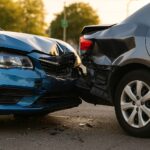Photo Credit Samuele Errico Piccarini In this post, Stillman and Friedland continue to update you on the latest in hi-tech automotive safety. We will look at how the new tech will impact you as we edge ever closer to autonomous driving systems. First, we will survey current trends and what is under development now. A lot of these innovations are coming faster than you might expect and, as usual, there are those who see a downside to the new technology.
A recent post at Autoblog lists trends spotted by in-the-know sources such as the AAA. Here are some of the top safety features appearing now. Most will be standard in a few years.
Advanced Driver Assistance Systems (ADAS) were pioneered by Intel’s Mobileye division, which is an Israeli hi-tech company. According to Mobileye these are engineered along a spectrum from driver response alerts to autonomous responses taken by the car:
“A passive system alerts the driver of a potentially dangerous situation so that the driver can take action to correct it. For example, Lane Departure Warning (LDW) alerts the driver of unintended/unindicated lane departure; Forward Collision Warning (FCW) indicates that…a collision is imminent. The driver then needs to brake in order to avoid the collision.
“In contrast, active safety systems take action. Automatic Emergency Braking (AEB) identifies the imminent collision and brakes without any driver intervention. Other examples of active functions are Adaptive Cruise Control (ACC), Lane Keeping Assist (LKA), Lane Centering (LC), and Traffic Jam Assist (TJA).”
• AAA cites the Forward Collision Warning & Automatic Emergency Braking technologies as the “most prevalent” safety feature now available. Today, around 30% of 2018 cars have these functions as a factory standard. Autoblog notes that nearly every vehicle produced will have these systems as standard by 2022.
Early sales of these devices, such as the Mobileye were add-ons to cars. Marketing sold these products as devices consumers should buy for their older parents to assist “senior driving.” Later, the automotive industry began building them in as a factory option. Today, there is a general agreement that these devices are a requirement for auto safety.
Demand for these safety features comes from both consumers and safety groups and NGOs; this has been clear for several years already. In fact, according to Car and Driver, “most major automakers… signed a memorandum of understanding with IIHS and NHTSA to have automated emergency braking on all vehicles by 2022.”
Car manufacturers are also keen to add these features, as they make the product safer and more desirable. One example of this is pointed out in Auto News, which notes that manufacturer Hyundai “offers safety features such as standard forward-collision warning, automatic emergency braking and rear cross-traffic alert, which are difficult to find at its price in a new or used vehicle.” There is a growing perception among automakers that safety equals sales.
Another safety intervention is the Blind Spot Monitor:
• This feature is available in different levels of function on the passive/active scale, depending on the manufacturer and model. According to Autoblog:
“Blind spot monitoring first appeared in the Volvo S80 in 2005 and a variation of it is included on many vehicles today, with some being more advanced than others…[One car company offers] a ‘blind spot intervention’ system which actually applies the brakes to guide your car away from switching lanes if someone is in your blind spot.”
Both Lane-Departure Warning and Lane-Keep Assistance are very useful for freeway driving; they are dependent on maintained roads that have easily detectable lane markings. Front end mounted cameras must be able to “read the road.” The system is then able to detect if the driver is straying out of the lane. Optimal operation for this system happens on well-lit freeways. The obvious drawback to the system is that it has less functionality if roads are poorly marked, and possibly less advance warning if the roads are poorly lit.
Another safety angle is two-pronged, focusing on Impact:
• Slow-down and
• Impact distribution
The Car and Driver magazine spotlights a new safety test in which frontal impact is partial, not full-on. In this type of crash, only a portion of the front end is impacted, as if you were to hit a guard rail, wall or just a corner of the back end of a truck. This new test eliminated many vehicles from the top safety rating category. Automatic braking to slow the car and reduce impact is combined with structural engineering to make the car safer.
“’If you can’t prevent a collision, from an energy standpoint, slowing down that vehicle by 5, 10, even 15 mph is a huge advantage, and it puts less stress on the vehicle’s structure and airbags,’ said Bautsch. Mitigating injury, it goes without saying, is better for the people inside as well.”
The engineers’ challenge is to take the impact from hitting one portion of the vehicle and distribute it through the structure to dissipate the force of the impact. To find out which small SUV vehicles performed best on this new IIHS test, click here. To see how severe a 40 mph crash can be, check out the video below, or one of the many crash tests available on the IIHS website:
Another case of a reduced-price cars offering advanced safety features is the Canadian budget model of the Tesla 3 compact sedan. This car features Lane Departure Avoidance and Emergency Lane Departure Avoidance. According to Cars.com, “the systems work independent of Autopilot, meaning that you don’t have to be in any form of self-driving mode to appreciate the advantages these features offer.”
The Lane Departure Avoidance feature activates if the sensors pick up movement out of the lane, but the turn signal has not been activated. If you are one of those people who are lackadaisical about using your turn signal, the car will alert you! If the Traffic Aware Cruise Control is activated, the car will turn on its hazard signals and slow down. An additional emergency Lane Departure feature can actively steer you back on track. Here is a key point to note:
• These controls are being installed by Tesla as the default operational mode.
• The driver can disable them, but the re-activate every time you turn on the car.
As Stillman and Friedland have pointed out in a number of posts, the end goal of all this technology is autonomously-driving cars. The driver of the future will be a monitor of the driving process, but the actual driving will be done by the car itself.
The key components of this technology, according to Cars.com, are:
• Sensors and monitoring systems: These include continuously checking car functions and reading the external environment, including the road and other drivers, as well as pedestrians.
• Computer processing of sensory monitoring systems: Rates in the speed and quantity of data onboard computers can handle are accelerating. This means that these systems are getting better and better at reading the car and the road. It also means that reaction time will be better, and more complex road conditions can be assessed quickly.
• Actuators: Braking and steering features which allow the car to respond when the driver fails to do so. These are the autonomous actors that carry out accident avoidance or amelioration.
The autonomous features readily check out operating parameters, such as speed and direction as well as engine performance. External sensors read the road, assess distance from objects or pedestrians, and generally allow the car to understand its dynamic surroundings. The increased function of these systems, and manufacturer experience are leading away from more passive alert systems, and toward greater vehicle autonomy. In a few years, autonomy will be a feature many drivers will have experienced and benefited from.
Familiarity with autonomous systems will reduce the inevitable pushback against these systems. The topic of consumer resistance came up recently in Europe Autonews as Volvo has decided to introduce a speed cap into one of its new models. Not that the top speed is so low—at 112 mph, no one is going to be crawling on the highway. It does mean that speed caps may very well become another safety feature.
The question is how much intrusion will the consumer accept? Or will there be any choice? Certainly, we are already with metadata scanning our shopping preferences. We depend on metadata scans to pick up security threats. If we are accustomed to our phones and home devices surveying our behaviors, we may not feel threatened by the same observation activities in our cars.
Another concern is that the systems will be hacker-proof. If data is uploaded online, it can be manipulated online as well. Citizens should ask hard questions regarding the hackability of these systems. The issue is probably less one of terror threats, than of groups of hackers who blackmail companies and governments with threats of disruptions. This has already been done.
Ultimately, though, we hope we are trading some of our privacy for better safety.
There are also economic considerations. Older vehicles will continue to work off grid. They will be a source of unpredictable driving. Will retrofitting them become a requirement? Or will there be “cash for clunkers” with new car prices beyond reach of the poor and no cheap private transportation?
The road to autonomous driving will be smoother and safer, but with many obstacles to pass before we get there.
Because we care…






